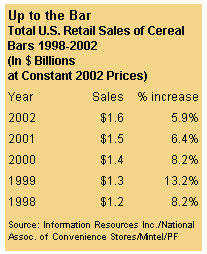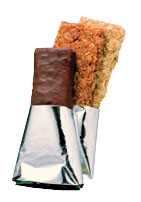
Mintel believes the market has a two-fold mission if it hopes to sustain its strong sales growth. First, more products must appeal to the heaviest user groups—those in the 15-24 and 65+ age groups. Note that the reasons for cereal bar consumption vary between these two groups. Younger consumers eat cereal bars more as a snack and, frequently, in conjunction with exercise. The older group is more apt to eat cereal bars in place of a meal.
Second, the category should work to attract new consumers in the under-consuming 25-64 age range. This demographic is likely to require new types of cereal bar products, such as those that merge confectionery, yogurt, coffee or other beverages. One option to grow consumption among this group has been to position cereal bars for specific benefits.
The cereal bar category is composed of two segments. The energy/diet portion has grown to nearly five times its 1997 levels and continues to grow far faster than the breakfast/snack segment. Dr. Atkins bars, Telford, Penn., and Slim-Fast bars, West Palm Beach, Fla., are among particularly successful energy/diet bars. Many such weight-loss-oriented items have targeted women, notably Clif Bars, Berkeley, Calif., and its line of Luna energy bars for women. On the other hand, Richardson Labs, Boca Raton, Fla., found success by expanding the focus of Balance bars and Powerbars from athletes—the original targets—to a much broader range of consumers.

Getting Specific
Still, the successful energy/diet bars are marketed specifically as energy or diet products, as those marketed as snacks fail to do as well among consumers. Despite this fact, cereal bars continue to be merchandised as impulse items. The reasons behind this are apparent: high single-bar profit margins, a wide range of offerings to appeal to most shoppers, and their varied uses (as a sweet snack, meal replacement, and health food product). Furthermore, Mintel's research found cereal bar consumers are more likely to snack and eat sweets frequently and try new nutritional products.
The primary venues for impulse purchases—convenience stores—have proven their worth in cereal bar sales. Sales of cereal bars in this channel, where roughly 20% of shoppers' purchases are impulse driven, hit $185 million in 2002, compared with the $33 million posted in 1997. This may not be a large share of the total cereal bar market, but it is enough to put convenience stores firmly into the second-largest channel spot behind supermarket sales at $1.2 billion (a 75.4% share).

Breakfast/snack bars built a market for the past 20 years and have become a staple as much as breakfast cereal, oatmeal and cookies. However, this leads to two concerns—maturation and competition. Regarding maturation, even the energy/diet segment is facing this problem. From 1998 to 2000, growth hovered around 50% annually. However, more recent years have seen annual growth dip into the 20% range.
While breakfast/snack bars share some traits with their energy/diet counterparts (most notably appearance and taste), the latter has different formulations of nutrients and, therefore, is marketed differently. Energy/diet bars may target a specific purpose such as weight loss, but they also cater to those with a specific goal in mind, i.e., for gaining strength, for women's health issues such as hot flashes, for diabetics, etc.

Bars Set
In terms of cereal bar sales, 14 brands hold 2% or more of the market. Brands of the breakfast/snack variety hold eight of the top nine places, as Slim-Fast is the only energy/diet bar to break into the top 10. Clif Bar, Ultra Slim-Fast, MetRx, Boca Raton, Fla., and Little Debbie snack bars (part of McKee Baking, Collegedale, Tenn.) boast shares just below that 2% threshold and, due to high growth rates, may surpass it in the next year.
Somewhat surprising is that the two segments have an entirely different set of leading manufacturers, though Mintel believes this is an indication that more industry consolidation is likely. Acquisitions over the last few years have left many of these top sellers in the stable of large manufacturers, with Atkins Diet and Clif Bar being notable exceptions. Some acquisitions have been general food purchases, as with Kellogg's, Battle Creek, Mich., buy of Keebler, Elmhurst, Ill., and PepsiCo's, Purchase, N.Y., purchase of Quaker, Chicago. Some acquisitions, however, have been with the express intent of entering into the cereal bar market with proven brands. These combinations include Unilever, Englewood Cliffs, N.J., and Slim-Fast; Nestle, Glendale, Calif., and Powerbar; and Kraft/Nabisco, East Hanover, N.J., and Balance Bar. A number of growing companies hold a 1.5-2% market share and could be takeover targets.

General Mills, Minneapolis, had instant success from its Milk 'n Cereal Bars, and imitators already have entered the market. The next wave of introductions will likely be cereal bar products from existing cereal brands. Furthermore, the innovations made in yogurt/cereal bars have resulted in products appealing to children, mothers, older consumers and those who want the health benefits of yogurt in a different way.
The premium concept also could hit the cereal bar segment, particularly those that promote a lifestyle message. One bar that makes such an attempt is the Ice Series from Clif Bar. Marketed as a beverage-in-a-bar, the Ice bars have a full shot of caffeine and are in flavors such as cool mint chocolate. Furthermore, indulgent cereal bars may prove key to reaching that 25-64 demographic.
For more information on the report, “The U.S. Cereal Bar Market,” contact Mintel International Group Ltd.; 213 W. Institute Place, Suite 208; Chicago, IL 60610; phone: 312-932-0400.
Website Resources
www.clifbar.com— Clif Bar Inc.www.generalmills.com— General Mills
www.keebler.com— Keebler
www.kelloggs.com— Kellogg's
www.littledebbie.com— Little Debbie
www.metrx.com— MetRx
www.nestleusa.com— Nestle USA
www.pepsico.com— PepsiCo
www.slimfast.com— Slim-Fast
www.unilever.com— Unilever
